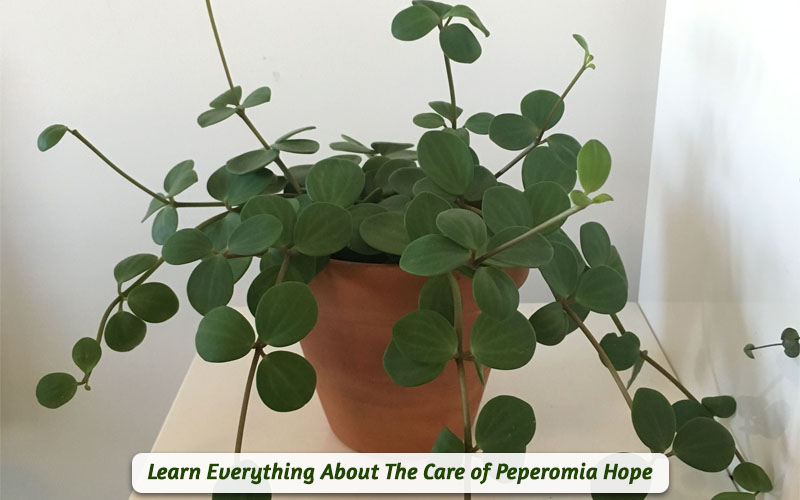Peperomia hope is really a hope for every plant-lover who doesn’t want to spend much time caring and maintaining the beauty they brought home.
It is a stunning, non-complaining, and forgiving plant that doesn’t demand much attention from you except the routine care, just like ponytail palm.
Native to South and Central America, Peperomia hope is a hybrid (combination) of peperomia quadrifolia x deppeana. This gorgeous plant from the genus peperomia requires minimal watering and high humidity.
Moreover, the hope plant can be used as a bucket houseplant to decorate the patio, balcony, lounge, or even your bedroom.
What more reasons do you need to get this charming beauty? Well, we have mentioned everything about the oh-so-magical hope peperomia.
Let’s plant-In!
How Do You Take Care of Peperomia Hope?

Peperomia care is relatively simple as it is among the list of ideal houseplants like sansevieria. And, it was cultivated to be suitable for care and growing so, it’s really not a hardy to care plant.
I am your Hope. You are my Hope. I am Peperomia Hope.
Here’s how you can take care of me the easy way:
Placement

Hope peperomia is not a challenging plant but more of an effortless plant.
This cultivar’s ideal placement is near a south-west facing window or spot where low to medium sunlight can reach.
Note: Plant peperomia is not a moody succulent that implies it will do well on the east-facing side too.
But, does the peperomia hope likes to sit in full sun? No!
Yes, you can use artificial fluorescent or growing lighting to fulfill the sunlight needs of your peperomia.
but,
These peperomia epiphytes will thrive in bright light, but too much can cause their leave to look dull and lifeless.
Of course, you don’t want that!
Temperature
The best practice is to choose a spot with an average temperature of 18°C to 25°C (64.4°F to 77°F).
This hybrid peperomia will do equally well in challenging conditions, but it’s better not to place them next to radiators in winter and air-conditioners in summer.
Your baby hope plant can’t tolerate cold and hot drafts.
Pro-Tip: Don’t grow these hope plants under 10°C (50°F), or they might actually lose hope. ;p
The botanical or scientific name of hope peperomia plants is Peperomia Rotundifolia. Whereas it is also known as trailing jade plant, radiator or hope plant, and round-leaf peperomia.
Soil

Peperomia hope is a hard-to-grow plant that requires well-drained and aerated soil (that doesn’t hold moisture) as the hope plant doesn’t like to sit in wet and soggy ground.
The best peperomia soil can be considered a rich potting mix with coarse sand, peat moss, perlite, or gravel.
Do It Yourself: You can also DIY the potting medium for your round-lead peperomia by mixing 1 part perlite or coarse sand and 2 parts peat moss.
According to a plant expert, Nick Pileggi, hope peperomia is a unique succulent as it grows actively in winters, unlike other succulents that show high growth in summers and spring.
Watering

The only tricky thing to learn about the peperomia hope care is their watering requirements.
A little goes a long way, fits right when it comes to watering care of peperomia hope plants.
Overall, these radiator plants are included among the reliable peperomia species to grow, but you can say one must be careful while watering them.
Water your trailing peperomia every 8-14 days.
You can also adopt a drench-dry method for your peperomia houseplant but, make sure to let the top (2″-3″) soil dry before you water the succulent again.
Water only when it’s 100% dry! don’t let your ‘hope’ lose his hope! (You see what we did here 😉)
Just like peperomia prostrata, they hate being overwatered. And, over-watering will only make their leaves yellow, droopy, and soggy.
Moreover, it can cause root rot, scab protrusions (on leaves), and stems to get soft, eventually deteriorating the plant as they have a small root system.
Pro-Tip: Insert your finger into the soil. If it feels dry, water your peperomia succulent, and if it feels moist, leave it be. Just don’t risk your plant!
If you don’t over-water it, your peperomia will thrive, or else it will lose all its hype!
Humidity
Round-leaf peperomia or hope plant is an easy to grow plant and demands environmental conditions with medium to high humidity.
So, is peperomia hope a good indoor plant? Yes! (you can reread the above line. ;p)
Provide an average of 50% humidity level to let your hope peperomia thrive and prosper.
If your house is less humid, use a humidifier to ensure your precious hope is getting all the hope for its healthy growth and future.
Fertilizer
This trailing jade plant is not tricky to handle, but a well-balanced fertilizer like 10-10-10 or 1-1-1 is ideal. You can also give them any succulent fertilizer but remember to dilute the fertilizer to half strength.
Forgiving peperomia just needs to be fertilized once a month or once every two weeks in the growing season but don’t fertilize them during winters.
Note: Every optimum plant care depends on their placement and environmental conditions they are growing in.
So, if you observe your peperomia growing actively all-year-around, you can adapt a regular fertilizing routine to fulfill its nutrients needs.
In the 1st year, your peperomia hope will sleep, In the 2nd year, he will give you creeps, and In the 3rd year, he will show you how well he can leap.
Potting & Repotting

The first and foremost tip is Not to Repot Often. Because peperomia hope has a small root system and frequent potting and repotting will only affect its growth.
The ideal time to repot is when you notice the peperomia hope is getting out of pot, drainage hole, or has started to dry out quickly.
For the best growth, go an inch higher for pot size, fill it with fresh soil-mix at the bottom, and carefully place your plant into the pot (don’t damage the stems).
Your peperomia hope will love a shallow pot as small pots won’t let the soil get waterlogged.
Pro-Tip: Check for brown, mushy, or rotted roots while repotting for a healthy hope peperomia.
Propagation
Stem cutting and leaves are two ways to propagate peperomia hope plants.
Stem Cutting Method:
Propagating peperomia through a stem cutting is as simple as it sounds. Cut a stem (3″ or 8cm) with a tree grafter kit above the node (with two-three leaves), let it callous over, lastly, put it into water.
And, it is off to a good start to produce new roots.
Once the roots have been developed, take some fresh and old soil mix (from the parent plant) on a mess-free gardening mat.
Mix well and put your newly prepared potting mix into a new pot. Carefully place the root into it and let it grow.
Pro-Tip: Place the freshly developed roots in a warm, humid, and bright room. Keep misting regularly as growing plants require more care.
Leaf Cutting Method:
The primary care is also the same for this method minus the water-rooting step. Pluck the leaves with petioles from the hope plant and put them directly into the soil.
Cover with the plastic bag (for extra heat) and mist every two days.
Note: Pay a little attention to the growing baby peperomia, like check the soil moisture and watering needs.
And, after few weeks, treat them as their parent hope peperomia plants.
Peperomia hope is a slow grower plant. If you are not providing them with enough light, they will become even slower. Bright indirect sunlight and a little watering are crucial for good growth peperomia.
Here is a video of peperomia hope propagation through leaf cuttings:
Pruning
Although peperomia hope is included among the slow-growing species, but these are also famous as trailing plants that can grow stems up to 18″ or 45cm long.
So, occasional pruning and maintenance are required to maintain the beauty of this gorgeous houseplant.
Remove any damaged leaves, infected stems, and pluck out any leaves that are ruining the appearance of your evergreen epiphyte plant.
The trailing nature of peperomia hope makes it an ideal choice for a hanging plant. Choose a place where it can get enough bright light and let it spell the magic in your surroundings.
Flowering
Does peperomia hope bloom flowers? No! but, we are sure the hanging basket plant’s stunning appearance will make it up for this.
In some cases, one may observe tiny flowers on the spiky stems of peperomia, but they are tough to notice.
Common Issues
Peperomia hope is a relatively reliable and easy-to-grow plant, but there could still be some issues like pests, yellow, and dull leaves.
1.Leaves Curling
There could be two reasons why the leaves of peperomia hope are curling, either they are over-fertilized, or they are under-attack of bugs.
2. Pests
White cotton masses on the undersides of leaves or the stems signal that your hope peperomia is under the attack of pests or mealybugs.
2 teaspoon Neem oil and equal parts of lukewarm water with liquid dish soap solution can help eliminate both.
Note: You can also add the insecticidal DIY solution in a spray bottle and mist it all over your plant.
3. Yellow & Droopy Leaves
Yellowy droopy leaves are all signs that you have over-watered your peperomia hope. Over-watering can also cause the root to rot and the stem to soft.
Remember to check the moisture or dryness of soil before you decide to water your plant.
4. Dull & Lifeless Leaves
If you observe your peperomia leaves to look like someone has sucked the life out of them, it is time you move them towards shading. Yes, you are throwing too much light their way!
Discolored leaves can also mean your plant is over-watered.
Final Thoughts
If you are a succulent lover but don’t know whether you should get a houseplant or not, this easy-to-care-for peperomia hope is ideal for you.
It’s hard to tell why this rare plant is not so talked-about when it is among the best houseplants one can get.
But, if you’re still confused, buy one hope plant and provide it with your occasional care, and you will see your peperomia thriving on its own.
If you’re interested to know more about such easy-to-grow, stunning, and forgiving plants make sure to visit Inspire Uplift Blog.
Because we take your opinion seriously!

